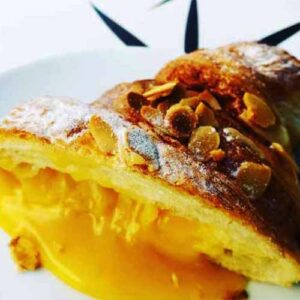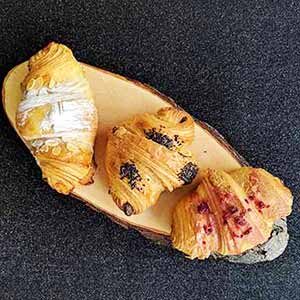
The so-called French Croissant, contrary to what many people think, is not of French origin, but Austrian.
Its origin is considered to be one of the greatest legends of all time.
Among the many known legends, the one below stands out.
In 1683, the Ottoman Empire of Turkish origin (one of the strongest empires in the world) was trying to expand its dominion by invading European lands.
But they found it very difficult to enter the city of Vienna, the Austrian capital.
So they decided to take advantage of the darkness of night to dig some tunnels that would lead them to the center of the city.
But they didn't count on the bakers of Vienna, who, working at dawn, heard them and denounced them.
The story goes that the bakers were offered some rewards.
But they didn't accept them. Except for the exclusive right to create something to commemorate their victory over the enemy.
And so the little half-moon-shaped puff pastries came into being, which they called "kipfel".
It was only later, around 1770, that the croissant arrived on French soil, through Marie Antoinette, who became Queen when she married French King Louis XIV.
Forbidden to maintain any ties to her homeland, instead of following the tradition of court food with the other diners, she chose to eat her "kipfel", one of the few things that reminded her of her origins.
He later renamed it a croissant.
Croissant in French means "crescent" and represents the shape of a half moon, allusive to the flag of the Ottoman Empire. Et voilà... The Croissant was created and became part of the French pastry.
In the 18th century, the croissant was just an improved bread dough.
Only around 1920 was it created by Parisian bakers as it is known today.
The main characteristic of the croissant - and also its secret - is in the dough.
This semi-flat dough has less fat, fewer folds and biological yeast.
The folds are responsible for the separation of the dough and fat layers, which provide the croissant's "puffiness".
A good croissant should look good, with a crescent shape, a crispy crust and a nice golden color.
The edges should be detached from the middle, the crumb should be sandy and show the right consistency.
Over time, it has become a gastronomic icon in the most diverse bakeries around the world.
Today, the croissant can be made with different fillings and can easily be found in sweet or savory versions.
It is a French icon and it is humanly impossible to visit France and ignore croissants.

Croissant dough is a leavened puff pastry like pains au chocolat.
It uses the same principles as normal puff pastry, except that it contains baker's yeast.
Yeast puff pastry requires less butter than conventional puff pastry.
In 1968, according to Jean-Léon and Jean-Georges Kiger in France, the eight stages of croissant production were as follows, and they are still the same today.
The raw materials used are flour, sugar, butter, yeast and water;
It is the main stage of the manufacturing process and determines the consistency and texture of the dough.
The aim of dividing is to form pieces of dough from the quantity obtained;
Rolling consists of passing the mass between two smooth cylinders, rotating in opposite directions, at the same speed and according to an adjustable spacing.
This phase leads to gasification;
It rests at 3°C for half an hour to an hour.
Expansion is followed by further rolling, which consists of two more passes.
In the end, the dough is about 3mm thick;
This is the step that will give it its final shape.
It is cut into identical longitudinal strips and then into triangles, before being rolled up;
At this stage the croissant dough only goes through one fermentation stage.
The growth takes place for 3 hours at 25°C.
Under the yeast development, the gas pressure increases and the alveoli grow.
Each croissant triples in volume;
Baking is done at 180°C. The steam produced during cooking will separate the different layers of the puff pastry.
After cooking, it has a crunchy, crumbly texture.

As with bread, the croissant is ideally baked in an oven that enhances crispness and is the true mark of quality, know-how, and craftsmanship.
In total, there are about fifty parameters to master to make a good croissant, including the quality of the flour, yeast and butter used, the fermentation time of the dough, how to incorporate the butter, modeling, heat of the oven, baking ...
Today, the low profitability of this product and the lack of time and skilled labor have led some bakers and pastry chefs to replace butter with margarine and make croissants with frozen dough.
It is estimated that more than 80% of croissants and sweets purchased in traditional bakeries are industrial frozen products.
That's not the case in Dacquoise.
Get to know some examples of our collection of Fine Pastries
Pastry and Bakery with own Handmade Manufacturing
Healthy Food, Daily Brunch; Catering
Lunches and Snacks;
Breakfast Menus;
Relaxed environment, friendliness and professionalism
Factory and Shop:
Rua Tomás da Anunciação, 109 A
1350-325 Lisbon
Open Tuesday to Saturday:
from 08h30 - 18h00
Closed on Sundays and Mondays